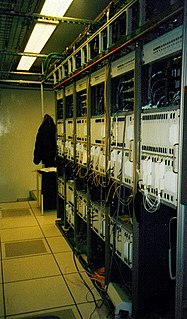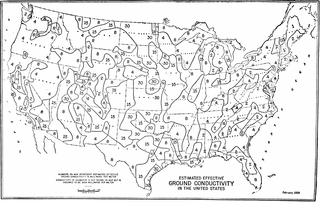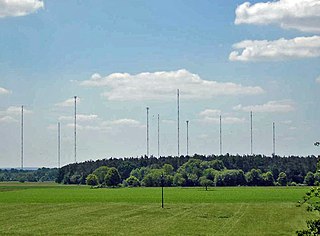Related Research Articles

The ITU Telecommunication Standardization Sector (ITU-T) coordinates standards for telecommunications and Information Communication Technology such as X.509 for cybersecurity, Y.3172 and Y.3173 for machine learning, and H.264/MPEG-4 AVC for video compression, between its Member States, Private Sector Members, and Academia Members. ITU-T is one of the three Sectors of the International Telecommunication Union (ITU).

The Open Systems Interconnection model is a conceptual model that characterises and standardises the communication functions of a telecommunication or computing system without regard to its underlying internal structure and technology. Its goal is the interoperability of diverse communication systems with standard communication protocols.
In telecommunications, RS-232, Recommended Standard 232 is a standard originally introduced in 1960 for serial communication transmission of data. It formally defines signals connecting between a DTE such as a computer terminal, and a DCE, such as a modem. The standard defines the electrical characteristics and timing of signals, the meaning of signals, and the physical size and pinout of connectors. The current version of the standard is TIA-232-F Interface Between Data Terminal Equipment and Data Circuit-Terminating Equipment Employing Serial Binary Data Interchange, issued in 1997. The RS-232 standard had been commonly used in computer serial ports and is still widely used in industrial communication devices.
The plesiochronous digital hierarchy (PDH) is a technology used in telecommunications networks to transport large quantities of data over digital transport equipment such as fibre optic and microwave radio systems. The term plesiochronous is derived from Greek plēsios, meaning near, and chronos, time, and refers to the fact that PDH networks run in a state where different parts of the network are nearly, but not quite perfectly, synchronized.

Synchronous optical networking (SONET) and synchronous digital hierarchy (SDH) are standardized protocols that transfer multiple digital bit streams synchronously over optical fiber using lasers or highly coherent light from light-emitting diodes (LEDs). At low transmission rates data can also be transferred via an electrical interface. The method was developed to replace the plesiochronous digital hierarchy (PDH) system for transporting large amounts of telephone calls and data traffic over the same fiber without the problems of synchronization.
Very high-speed digital subscriber line (VDSL) and very high-speed digital subscriber line 2 (VDSL2) are digital subscriber line (DSL) technologies providing data transmission faster than asymmetric digital subscriber line (ADSL).
The unit interval is the minimum time interval between condition changes of a data transmission signal, also known as the pulse time or symbol duration time.
Many services running on modern digital telecommunications networks require accurate synchronization for correct operation. For example, if telephone exchanges are not synchronized, then bit slips will occur and degrade performance. Telecommunication networks rely on the use of highly accurate primary reference clocks which are distributed network-wide using synchronization links and synchronization supply units.

Procedure signs or prosigns are shorthand signals used in Morse code radio telegraphy procedure, for the purpose of simplifying and standardizing radio communication protocol. They are several from Morse code abbreviations, which consist mainly of brevity codes that convey messages to other parties with greater speed and accuracy.
Latency refers to a short period of delay between when an audio signal enters a system and when it emerges. Potential contributors to latency in an audio system include analog-to-digital conversion, buffering, digital signal processing, transmission time, digital-to-analog conversion and the speed of sound in the transmission medium.

Ground conductivity refers to the electrical conductivity of the subsurface of the earth. In the International System of Units (SI) it is measured in millisiemens per meter (mS/m).
T-MPLS or Transport MPLS is a transport network layer technology that uses extensions to a subset of the existing MPLS standards and is designed specifically for application in transport networks. Work to define T-MPLS was started by the ITU-T in February 2006. It was intended specifically as a connection-oriented packet-switched (co-ps) application offering a simpler implementation by removing MPLS features that are not relevant to co-ps applications and adding mechanisms that provide support of critical transport functionality.
ITU-T Recommendation G.8261/Y.1361 "Timing and Synchronization Aspects in Packet Networks" specifies the upper limits of allowable network jitter and wander, the minimum requirements that network equipment at the TDM interfaces at the boundary of these packet networks can tolerate, and the minimum requirements for the synchronization function of network equipment.
Multiprotocol Label Switching - Transport Profile (MPLS-TP) is a variant of the MPLS protocol that is used in packet switched data networks. MPLS-TP is the product of a joint Internet Engineering Task Force (IETF) / International Telecommunication Union Telecommunication Standardization Sector (ITU-T) effort to include an MPLS Transport Profile within the IETF MPLS and PWE3 architectures to support the capabilities and functionalities of a packet transport network.
Synchronous Ethernet, also referred as SyncE, is an ITU-T standard for computer networking that facilitates the transference of clock signals over the Ethernet physical layer. This signal can then be made traceable to an external clock.
Security service is a service, provided by a layer of communicating open systems, which ensures adequate security of the systems or of data transfers as defined by ITU-T X.800 Recommendation.
X.800 and ISO 7498-2 are technically aligned. This model is widely recognized
Usage Parameter Control (UPC) and Network Parameter Control (NPC) are functions that may be performed in a computer network. UPC may be performed at the input to a network "to protect network resources from malicious as well as unintentional misbehaviour". NPC is the same and done for the same reasons as UPC, but at the interface between two networks.
International Mobile Telecommunications-2020 are the requirements issued by the ITU Radiocommunication Sector (ITU-R) of the International Telecommunication Union (ITU) in 2015 for 5G networks, devices and services.

Standard frequency and time signal service is – according to Article 1.53 of the International Telecommunication Union's (ITU) Radio Regulations (RR) – defined as «A radiocommunication service for scientific, technical and other purposes, providing the transmission of specified frequencies, time signals, or both, of stated high precision, intended for general reception.»
ITU-R Recommendation BT.2100, more commonly known by the abbreviations Rec. 2100 or BT.2100, introduced high-dynamic-range television (HDR-TV) by recommending the use of the perceptual quantizer (PQ) or hybrid log–gamma (HLG) transfer functions instead of the traditional "gamma" previously used for SDR-TV.
References
- ↑ Smith, David R. (2003). Digital Transmission Systems. Springer Science & Business Media. p. 652. ISBN 978-1-4020-7587-2.
- ↑ Manning, Trevor (2009). Microwave Radio Transmission Design Guide. Artech House. p. 88. ISBN 978-1-59693-457-3.